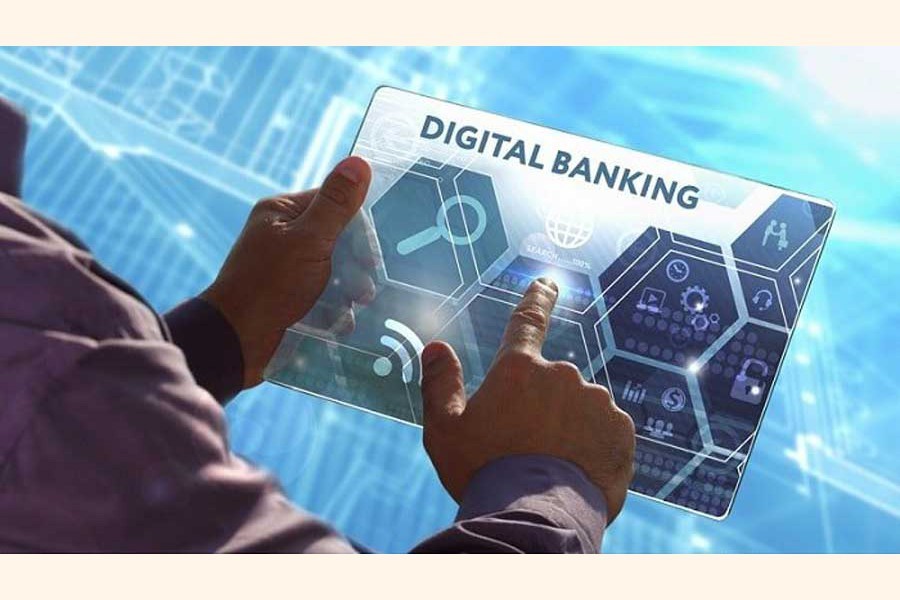
Published :
Updated :

Digital banking today has the possibility of being integrated into future routine activities across internet-enabled devices. It will make the entire process invisible, thanks to the potentials of personal digital assistants and digital financial wellness products. Growing mobile phone subscription and internet penetration have brought about an early success in the Mobile Financial Services (MFS) of Bangladesh, which can be enhanced through technology for autonomous banking experience. In addition, the concept of financial wellness apps, which seems a visualisation of the already incurred expenses, can be rethought in retail banking by offering sustainability in the clients’ lifestyle.
MFS to grow further with IoT support
There are 26 billion internet-connected devices around the world, which are expected to skyrocket to 75 billion in 2025. Bangladesh had 100 million mobile internet users until August 2020, according to telecom regulator BTRC. Furthermore, people’s tendency to avoid cash during Covid-19 ramped up MFS transactions in Bangladesh. Hence, MFS transactions increased by 41 per cent in October 2020 on a year-on-year basis.
The number could be amplified with the Internet of Things (IoT)-based banking services. To put it simply, it is about empowering wearables to make payments on behalf of the clients based on reliable programming. It is like driving to a gas station, filling up gas and the car autonomously paying for it as you leave the station. It could also be a smartwatch that would pay for groceries as the client leaves the super shop.

Voice banking the next big thing
Personal digital assistants (PDA) have thrived on intelligence to understand human command and do things on their behalf. On its way, the next big thing is voice banking as bankers and PDA developers like Alexa, Apple and Google collaborate because people are becoming “lazy,” said Benoit Legrand, ING’s (InternationaleNederlandenGroep) Chief Innovation Officer (CIO). The concept of transactional banking has transitioned from waiting in the queue with a cheque to going to ATMs to doing electronic transfers using mobile apps. Thus, the CIO predicted, ‘‘The next stage is to say, Alexa, transfer two euros to my mom. This is the next step in laziness."
He also warned that digital works are like oxygen. You need to ensure oxygen keeps running; otherwise the system will stop functioning. Hence, it may be argued that the more digital needs there are the more people there are involved in the support end. So, from the banking perspective, the best way to enhance the experience is to ensure that high-quality talents are at the right places to deliver 24/7 customer support.
Personal finance management hit new heights
While talking about financial wellness apps, a typical image that pops up in people’s mind is a pie chart that visualises the expenses made over a period of time. It often comes up with a repent over impulse buys made. Hence, these apps are based on the hope that someday the user will be able to manage purchases more appropriately, which rarely happens now. So, instead of waiting for the user to change the habit, retail bankers can offer personal financial management (PFM) that helps their clients to make planned expenditures.
It works in a very convenient way, for instance, a client wishes to buy a new iPhone that is going to be launched, say, in September this year, and the bank has offered a scheme where a fixed portion of the client's salary is going to be deposited in a purchase account till September for this purpose. In the month of September 2021, the principal with interest will be credited to the client’s main account to enable the purchase.
Now, there is a question regarding the cannibalisation of bank revenue streams as they make good income from credit card dues, typically charging a high rate of interest. Hence, as PFM products become more enriched, the revenue model of retail banking needs to be reshaped to offer clients a more sustainable financing solution. All leading banks in the world are now moving toward a concept of helping clients to choose the most efficient option like suggesting a lease, or buy, decision to the client looking for a car by collaborating with automobile companies. That means, it is the digital PFM services that will provide both banks and their clients with required avenues in future to grow sustainably, setting the stage for the future banking to potentially go invisible.
The writer is a treasury professional at a multinational FMCG company. He can be reached at wahidulislam041@gmail.com


 For all latest news, follow The Financial Express Google News channel.
For all latest news, follow The Financial Express Google News channel.